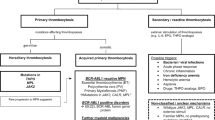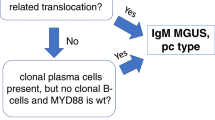Abstract
Although myelodysplastic syndromes (MDS) have been increasingly diagnosed in recent years, precise data on their prevalence and incidence are still lacking. Due to difficulties of diagnosis and classification, large-scale population-based studies that are required for obtaining truly representative data on the epidemiology of MDS are currently not available. Our present knowledge of the incidence and other epidemiological characteristics of MDS is based on a few regional studies performed by authors with a long-lasting interest in these hemopathies. Despite certain limitations, these studies have consistently shown that MDS are relatively common hematological malignancies. Their crude incidence varies from 2.1 to 12.6 cases per 100,000 people per year. Among the age group that is mainly affected, people older than 70 years, we are now faced with incidence rates of about 15 to 50 cases per 100,000 people per year. The recent increase in MDS incidence observed in some studies is probably not the result of an actual increase in the number of cases, but reflects improvements in geriatric medical care and diagnosis.
Similar content being viewed by others
References
Harris NL, Jaffe ES, Diebold J, et al. World Health Organization classification of neoplastic diseases of the hematopoietic and lymphoid tissues: report of the clinical advisory committee meeting-Airlie House, Virginia, November 1997.J Clin Oncol. 1999;17:3835–3849.
Bennett JM, Catovsky D, Daniel MT. et al. Proposals for the classification of the myelodysplastic syndromes.Br J Haematol. 1982;51:189–199.
Gallagher A, Darley RL, Padua RA. The molecular basis of myelodysplastic syndromes.Haematologica. 1997;191–204.
Hamilton-Paterson JL. Preleukaemic anaemia.Acta Haematol. 1949;2:309–316.
Aul C, Bowen DT, Yoshida Y. Pathogenesis, etiology and epidemiology of myelodysplastic syndromes.Haematologica. 1998;83:71–86.
Van Leeuwen FE. Risk of acute myelogenous leukaemia and myelodysplasia following cancer treatment.Baillieres Clin Haematol. 1996;9:57–85.
Cole P, Sateren W, Delzell E. Epidemiologic perspectives on myelodysplastic syndromes and leukemia.Leuk Res. 1995;19:361–365.
Reizenstein P, Dabrowski L. Increasing prevalence of the myelodysplastic syndrome. An international Delphi study.Anticancer Res. 1991;11:1069–1070.
öst A, Reizenstein P. Minimal diagnostic criteria for the myelodys-plastic syndrome.Leuk Res. 1992;16:9–11.
Foucar K, Langdon RM, Armitage JO, Olson DB, Carroll TJ. Myelodysplastic syndromes. A clinical and pathologic analysis of 109 cases.Cancer. 1985;56:553–561.
Juneja SK, Imbert M, Jouault H, Scoazec JY, Sigaux F, Sultan C. Haematological features of primary myelodysplastic syndromes (PMDS) at initial presentation: a study of 118 cases.J Clin Pathol. 1983;36:1129–1135.
Teerenhovi L., Lintula R. Natural course of myelodysplastic syndromes—Helsinki experience.Scand J Haematol. 1986;36(suppl 45):102–106.
Cunningham I, MacCallum SJ, Nicholls MD, et al. The myelodys-plastic syndromes: an analysis of prognostic factors in 226 cases from a single institution.Br J Haematol. 1995;90:602–606.
Kerkhofs H, Hermans J, Haak HL, Leeksma CHW. Utility of the FAB classification for myelodysplastic syndromes: investigation of prognostic factors in 237 cases.Br J Haematol. 1987;65:73–81.
Sanz GF, Sanz MA, Vallespi T, et al. Two regression models and a scoring system for predicting survival and planning treatment in myelodysplastic syndromes: a multivariate analysis of prognostic factors in 370 patients.Blood. 1989;74:395–408.
Morel P, Hebbar M, Lai JL, et al. Cytogenetic analysis has strong independent prognostic value in de novo myelodysplastic syndromes and can be included in a new scoring system: a report on 408 cases.Leukemia. 1993;7:1315–1324.
Goasguen JE, Garand R, Bizet M, et al. Prognostic factors of myelodysplastic syndromes—a simplified 3-D scoring system.Leuk Res. 1990;14:255–262.
Maschek H, Gutzmer R, Choritz H, Georgii A. Life expectancy in primary myelodysplastic syndromes: a prognostic score based upon histopathology from bone marrow biopsies of 569 patients.Eur J Haematol. 1994;53:280–287.
Greenberg P, Cox C, LeBeau MM, et al. International scoring system for evaluating prognosis in myelodysplastic syndromes.Blood. 1997;89:2079–2088.
Oguma S, Yoshida Y, Uchino H, Maekawa T, Nomura T, Mizoguchi H. Clinical characteristics of Japanese patients with primary myelodysplastic syndromes: a co-operative study based on 838 cases.Leukemia. 1995;19:219–225.
Paydas S, Kocak R. Younger age observation in myelodysplastic syndrome [letter].Leuk Res. 1996;20:367.
Fenaux P, Preudhomme C, Estienne MH, et al. De novo myelodys-plastic syndromes in adults aged 50 or less. A report on 37 cases.Leuk Res. 1990;14:1053–1059.
Ribera JM, Cervantes F, Rozman C. A multivariate analysis of prognostic factors in chronic myelomonocytic leukaemia according to the FAB criteria.Br J Haematol. 1987;65:307–311.
Van den Berghe H, Vermaelen K, Mecucci C, Barbieri D, Tricot G. The 5q-anomaly.Cancer Genet Cytogenet. 1985;17:189–225.
Pedersen B. 5q- survival: importance of gender and deleted 5q bands and survival analysis based on 324 published cases.Leuk Lymphoma. 1998;31:325–334.
Aul C, Gattermann N, Schneider W. Age-related incidence and other epidemiological aspects of myelodysplastic syndromes.Br J Haematol. 1992;82:358–367.
Barrett J, Saunthararajah Y, Molldrem J. Myelodysplastic syndromes and aplastic anemia: distinct entities or diseases linked by a common pathophysiology?Semin Hematol. 2000;37:15–29.
Williamson PJ, Kruger AR, Reynolds PJ, Hamblin TJ, Oscier DG. Establishing the incidence of myelodysplastic syndrome.Br J Haematol. 1994;87:743–745.
Cartwright RA. Incidence and epidemiology of the myelodys-plastic syndromes. In: Mufti GJ, Galton DAG, eds. The Myelodys-plastic Syndromes. Edinburgh, Scotland: Churchill Livingstone. 1992:23–31.
Radlund A, Thiede T, Hansen S, Carlsson M, Engquist L. Incidence of myelodysplastic syndromes in a Swedish population.Eur J Haematol. 1995;54:153–156.
Maynadié M, Verret C, Moskovtchenko P, et al. Epidemiological characteristics of myelodysplastic syndromes in a well-defined French population.Br J Cancer. 1996;74:288–290.
Bauduer F, Ducout L, Dastugue N, Capdupuy C, Renoux M. Epidemiology of myelodysplastic syndromes in a French general hospital of the Basque Country.Leuk Res. 1998;22:205–208.
Shimizu H, Matsushita Y, Aoki K, Nomura T, Yoshida Y, Mizoguchi H. Prevalence of the myelodysplastic syndromes in Japan.Int J Hematol. 1995;61:17–22.
Saarni MI, Linman JW. Preleukemia: the hematologic syndrome preceding acute leukemia.Am J Med. 1973;55:38–48.
McNally RJQ, Roman E, Cartwright RA. Leukemias and lym-phomas: time trends in the UK, 1984-93.Cancer Causes Control. 1999;10:35–42.
Aul C, Gattermann N, Germing U, Runde V, Heyll A. Myelodys-plastische Syndrome. Epidemiologische und ätiologische Aspekte.Dtsch Med Wschr. 1992;117:1223–1231.
Pedersen-Bjergaard J, Philip P, Larsen SO, et al. Therapy-related myelodysplasia and acute myeloid leukemia. Cytogenetic characteristics of 115 consecutive cases and risk in seven cohorts of patients treated intensively for malignant diseases in the Copenhagen series.Leukemia. 1993;7:1975–1986.
Pui CH, Ribeiro RC, Hancock ML, et al. Acute myeloid leukemia in children treated with epipodophyllotoxins for acute lym-phoblastic leukemia.N Engl J Med. 1991;325:1682–1687.
Travis LB, Li CY, Zhang ZN, et al. Hematopoietic malignancies and related disorders among benzene-exposed workers in China.Leuk Lymphoma. 1994;14:91–102.
Honda Y, Delzell E, Cole P. An updated study of mortality among workers at a petroleum manufacturing plant.J Occup Envir Med. 1995;37:194–200.
Nisse C, Lorthois C, Dorp V, Eloy E, Haguenoer JM, Fenaux P. Exposure to occupational and environmental factors in myelodys-plastic syndromes. Preliminary results of a case-control study.Leukemia. 1995;9:693–399.
Mele A, Szklo M, Visani G, et al. Hair dye use and other risk factors for leukemia and pre-leukemia: a case-control study.Am J Epidemiol. 1994;139:609–619.
Correa A, Mohan A, Jackson L, Perry H, Helzlsouer K. Use of hair dyes, hematopoietic neoplasms, and lymphomas: a literature review, I: leukemias and myelodysplastic syndromes.Cancer Invest. 2000;18:366–380.
Author information
Authors and Affiliations
Corresponding author
About this article
Cite this article
Aul, C., Giagounidis, A. & Germing, U. Epidemiological Features of Myelodysplastic Syndromes: Results From Regional Cancer Surveys and Hospital-Based Statistics. Int J Hematol 73, 405–410 (2001). https://doi.org/10.1007/BF02994001
Received:
Accepted:
Published:
Issue Date:
DOI: https://doi.org/10.1007/BF02994001




